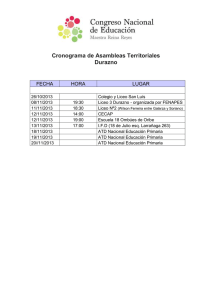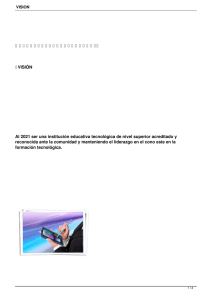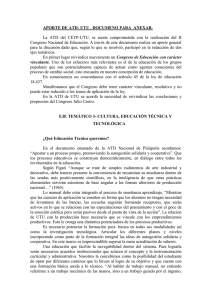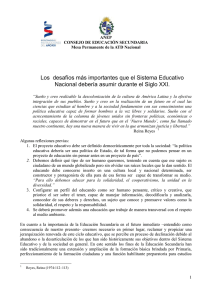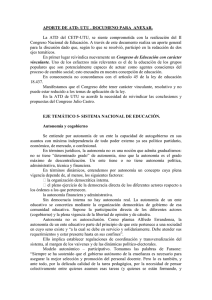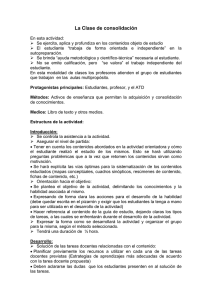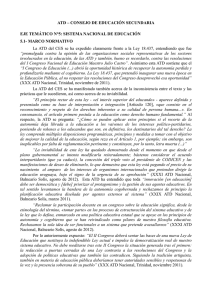DIAGNÓSTICO DE ALTERACIONES DE LA VISIÓN DEL COLOR
Anuncio
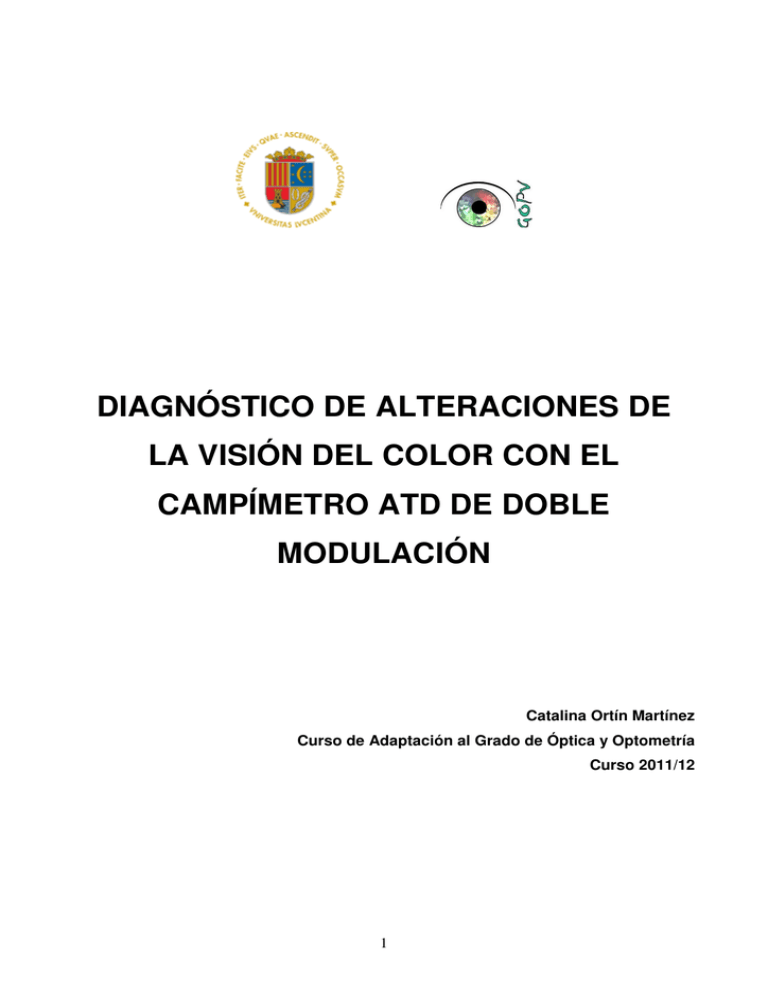
DIAGNÓSTICO DE ALTERACIONES DE LA VISIÓN DEL COLOR CON EL CAMPÍMETRO ATD DE DOBLE MODULACIÓN Catalina Ortín Martínez Curso de Adaptación al Grado de Óptica y Optometría Curso 2011/12 1 DOLORES DE FEZ SAIZ, VICENTE JESÚS CAMPS SANCHÍS, PROFESORES TITULARES de la Universidad de Alicante CERTIFICAN: Que CATALINA ORTÍN MARTÍNEZ, ha realizado bajo su supervisión el trabajo de investigación que se recoge en la presente memoria, cumpliendo las condiciones necesarias para ser presentado y defendido frente al tribunal correspondiente. Este trabajo constituye la asignatura “Trabajo Fin de Grado” prevista en el plan de estudios del Curso de Adaptación al Grado de Óptica y Optometría impartido por la Universidad de Alicante. Y para que conste a los efectos oportunos, firman el presente certificado en Alicante, Mayo de 2012, Fdo. DOLORES DE FEZ SAIZ Fdo. VICENTE JESÚS CAMPS SANCHÍS. 2 ÍNDICE PÁGINA RESUMEN 1 1.-INTRODUCCIÓN 3 • 1.1.-LÁMINAS DE ISHIHARA 6 • 1.2.-ANOMALOSCOPIO DE DAVICO 7 • 1.3.-FARNSWORTH-MUNSELL 100HUE 8 • 1.4.-EL CAMPÍMETRO COMO MÉTODO 9 DIAGNÓSTICO 2.-OBJETIVOS 11 3.-METODOLOGÍA 12 • 3.1.-LÁMINAS DE ISHIHARA 12 • 3.2.-ANOMALOSCOPIO DE DAVICO 14 • 3.3.- FARNSWORTH-MUNSELL 100HUE 16 • 3.4.-CAMPÍMETRO ATD DE DOBLE 17 MODULACIÓN 4.-RESULTADOS Y DISCUSIÓN 21 5.-CONCLUSIONES 51 6.-REFERENCIAS 52 ANEXO 54 3 El objetivo de este trabajo es realizar un estudio comparativo entre los test habitualmente utilizados para la detección de las alteraciones de la visión del color que todos conocemos; las láminas de Ishihara, el anomaloscopio de Davico y el test Farnsworth-Munsell 100Hue, con el campímetro ATD de Doble Modulación. El campímetro es el instrumento destinado a medir la extensión del campo visual y compuesto de un fondo sobre el cual se desplazan los estímulos. El dispositivo usado en este trabajo tiene la particularidad de poder seleccionar las características de esos estímulos: la cromaticidad, la frecuencia espacial y la frecuencia temporal. En particular, para la cromaticidad se trabaja en un modelo de visión ATD, pudiendo definir el estímulo en cualquiera de las tres direcciones cardinales del modelo: acromático (A), rojo-verde (T) o azul-amarillo (D). En nuestro estudio evaluaremos monocularmente a seis pacientes con las pruebas convencionales, además de realizar monocularmente también dos campimetrías. Para las campimetrías seleccionamos la frecuencia espacial de 0 cpg y la temporal de 0 Hz, ya que no buscamos respuestas que dependan de la visión espacial o temporal del paciente. Se han seleccionado los mecanismos T y D en lugar del convencional acromático (A) para, posteriormente en las conclusiones, comparar la precisión de estas pruebas con los test habituales. Como población control se utilizará un conjunto de 7 sujetos normales diagnosticados con las mismas pruebas. Figura: Láminas Ishihara y Farnsworth Munsell 100 Hue 4 The aim of this paper is to present a comparative study of the commonly used tests for the detection of abnormal colour vision, familiar tests such as, the Ishihara plates, the Davico Anomoloscope, the Farnsworth-Munsell 100Hue and the Perimeter ATD Dual Modulation test. The Perimeter ATD is the instrument to measure the extent of visual field and consist of a background against which moving stimuli are visible. The device used in this study is unique in its ability to select the characteristics of these stimuli; in particular, chromaticity, spatial frequency and temporal frequency. In particular, the chromaticity is working on a vision model ATD which may define the stimulus in any of the three directions of the model: achromatic (A), red-green (G) or blue-yellow (D). In our study we monocularly evaluated six patients with conventional tests, in addition to these; we also conducted two biomicroscopic tests, both of which were also monocular. The biomicroscope selected had a spatial frequency of 0cpg and frequency from 0Hz and we did not seek answers that depended on the spatial or temporal view of the patient. Mechanisms T and D have been selected in place of conventional achromatic (A) mechanism. So later in the conclusions, we will able to compare the accuracy of these tests with the standard test. For a control population, we used a set of seven normal subjects diagnosed by means of the same tests. 5 Comprobamos que se han alcanzado los objetivos propuestos al comenzar este estudio: • El campímetro ATD de doble modulación nos permite diagnosticar el mecanismo cromático que presenta un comportamiento por debajo de lo que se considera normal. • En las campimetrías de estos pacientes, observamos una bajada en la sensibilidad en el canal T, incluso en uno de los casos llega a ser nula, mientras que el canal D se ha asimilado al paciente normal. • Los resultados concuerdan con el tipo de alteraciones de la visión del color de los pacientes que han colaborado en el estudio, ya que todos ellos han sido diagnosticados como anómalos rojo-verde. Check that objectives have been achieved at the beginning of this study: • The Perimeter ATD Dual Modulation allowed us to diagnose the losses in a particular chromatic mechanism compared to normal population. • In anomalous chromatic population, we observed a decrease in sensitivity in the T mechanism, which, in one case even showed zero sensibility, while the D channel sensibilities were assimilated into normal patient range. • These results are consistent with the type of changes in colour vision of patients who have collaborated in the study because they have all been diagnosed with redgreen abnormalities. 6 1- Gegenfurtner,K. R., Sharpe, L.T. Color vision. From genes to perception.Cambridge University Press 1999. 2- Hubel, D.H. Ojo, cerebro y visión. Universidad de Murcia 1999 3- Artigas J M , Capilla P , Felipe A y Pujol J. Óptica fisiológica. Psicofísica de la visión . Mcgrau-Hill-Interamericana de España .1995 : 253-260. 4-- Pérez V V, de Fez D, Martínez F. Colour vision: theories and principles. En: Gulrajani ML. Colour measurement. Principles, advances and industrial applications. Cambridge: 2010. p. 1-18. 5- De Valois, K. Seeing. Academic Press 2000 6-- Tovee MJ. An introduction to the Visual System. Cambridge: Cambridge University Press; 2009 7- Capilla, P., Artigas, J.M., Pujol, J. Fundamentos de colorimetría. Publicaciones de la Universidad de Valencia (2002). 8- D.H.Foster, “Inherited and acquired colour vision deficientes: fundamental aspects and clinical Studies, en vision and visual dysfunnctions”,Houndmills: MacMIllan Press Scientific&Medical, 1991 9-. The series of plates designed as a test for colour deficiency. Shinobu Ishihara, 2007. Manual del fabricante. 10- Procedures for Testing Color Vision, Report of Working Group 41 Committee on Vision, Assembly of Behavioral and Social Sciences, National Research Council, NATIONAL ACADEMY PRESS.Washington, D.D.1981. 11- Farnswoth D. The Farnswoth-Munsell 100 hu and dichotomous test for color vision. J Opt Soc Am 1943 ;33 ; 568-578. 12- Examen de Vision de Matices de Color Farnsworth-Munsell 100. Disponible en: http://www.atamez.com/atamez_Color_Consulting/FarnsworthMunsell_100_Hue_Test.html. Fecha de acceso:24-5-2012. 13- Fristrom B. Peripheral and central colour contrast sensitivity in diabetes. Acta Ophthalmol Scand 1998;76:541–5. 7 14- Harwerth RS, Carter-Dawson L, Smith EL III, Barnes G, Holt WF, Crawford ML. Neural losses correlated with visual losses in clinical perimetry. Invest Ophthalmol Vis Sci 2004;45:3152–60. 15-Estudio clínico del campímetro: “Analizador ATD de Doble Modulación”. Disponible en : http://www.fom.es/es/li-calidad-visual/254/estudio-clinico-del-campimetro-analizador-atdde-doble-modulacion. Fecha de acceso: 24-5-2012. 16- Morilla-Grasa A, Antón A, Santamaría S, Capilla P, Gómez-Chova J, Luque MJ, Artigas JM, Felipe A. Contrast sensitivity differences between glaucoma, ocular hypertensive and glaucoma suspect patients found by ATD perimetry, ARVO 2009, Invest. Ophthalmol.Vis. Sci. 2009. 50: Issue 5; E-Abstract 5290 17- P.R.Kinnear, A. Sahraie,”New Farnsworth-Munsell 100 hue test norms of normal observers for each year of age 5-22 and for age decades 30-70”, pp 1408-1411, November.2011 18-- Analizador ATD de doble modulación. Manual de usuario. Cedido por la Universidad de Valencia.2007. 19- Fristrom B. Peripheral and central colour contrast sensitivity in diabetes. Acta Ophthalmol Scand 1998; 76:541–5. 8
